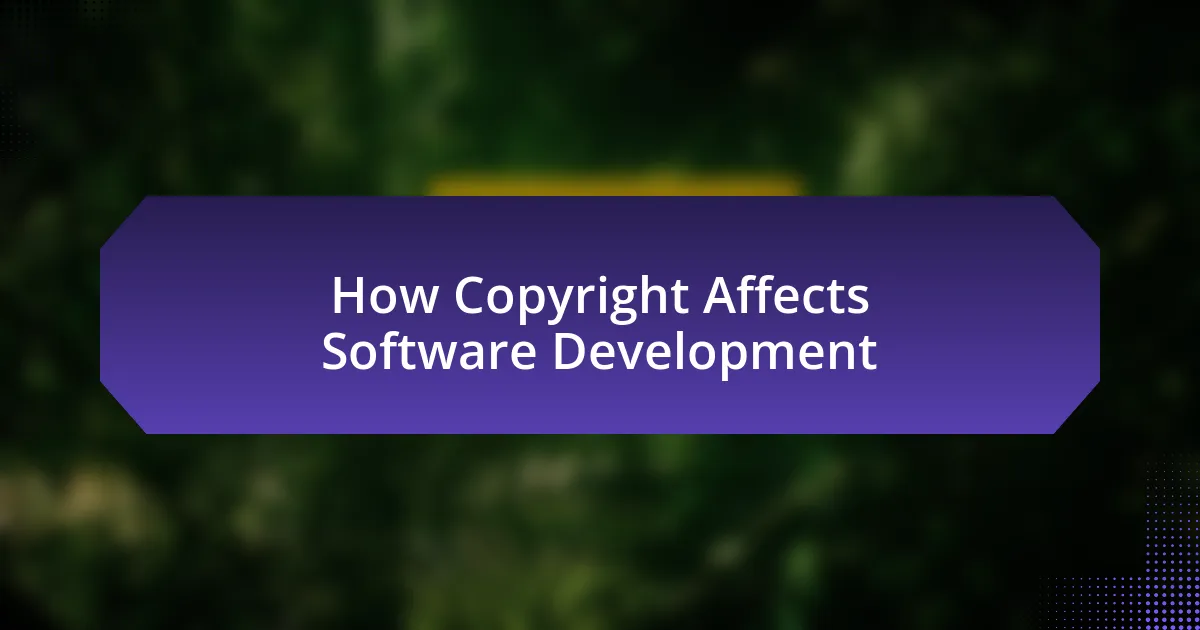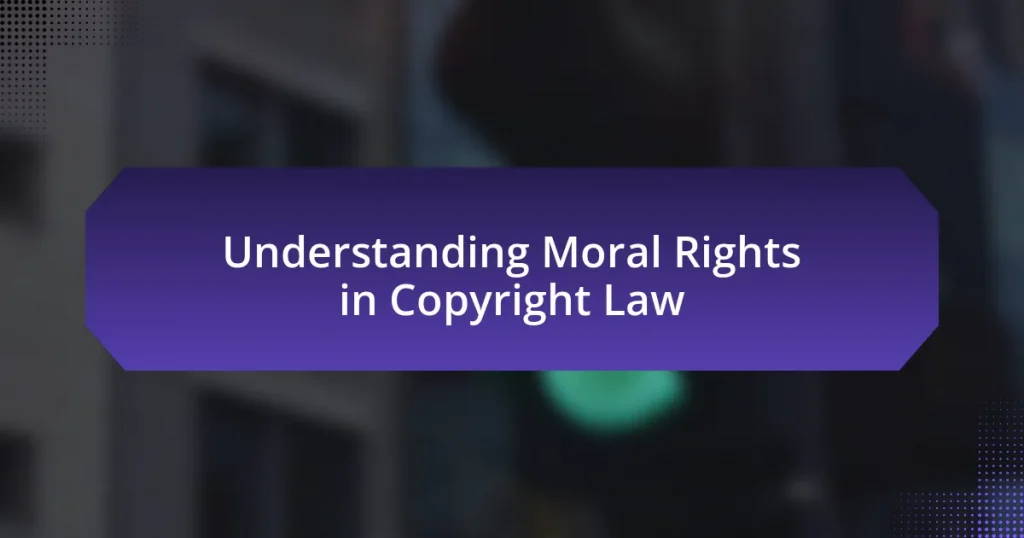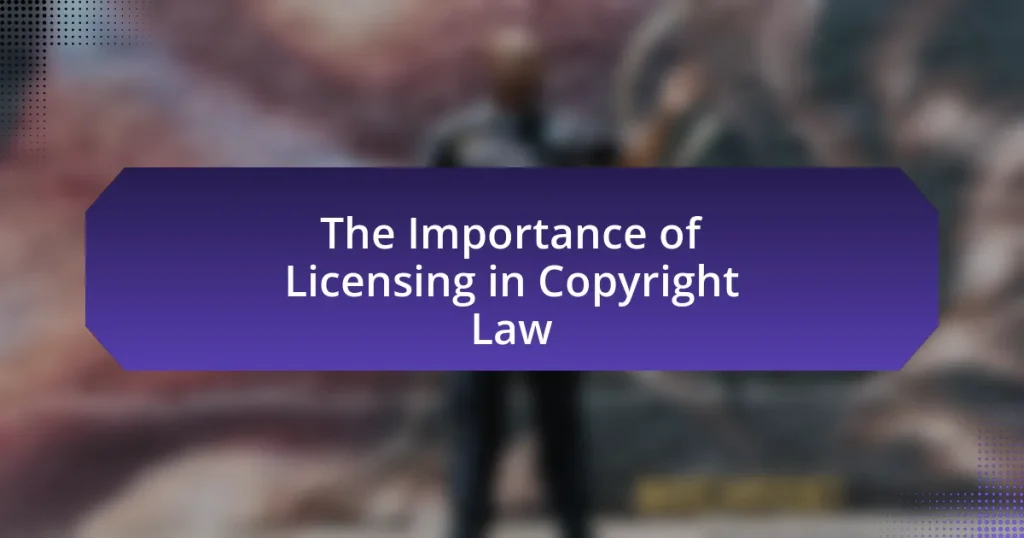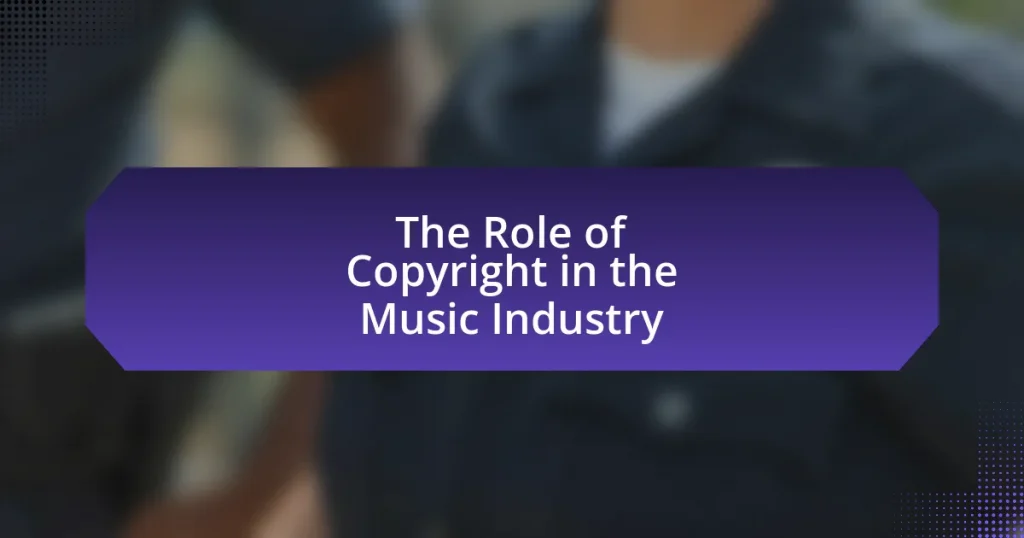Copyright plays a crucial role in software development by providing legal protection for original code and designs, which fosters innovation and investment. The article explores the fundamental principles of copyright, including the exclusive rights granted to creators and the limitations that exist, such as the inability to protect underlying ideas or algorithms. It discusses how copyright safeguards software code and documentation, the implications of copyright infringement, and the challenges developers face in navigating copyright laws. Additionally, the article examines the interaction between copyright and open-source licenses, the importance of compliance, and the future trends in copyright practices influenced by emerging technologies.
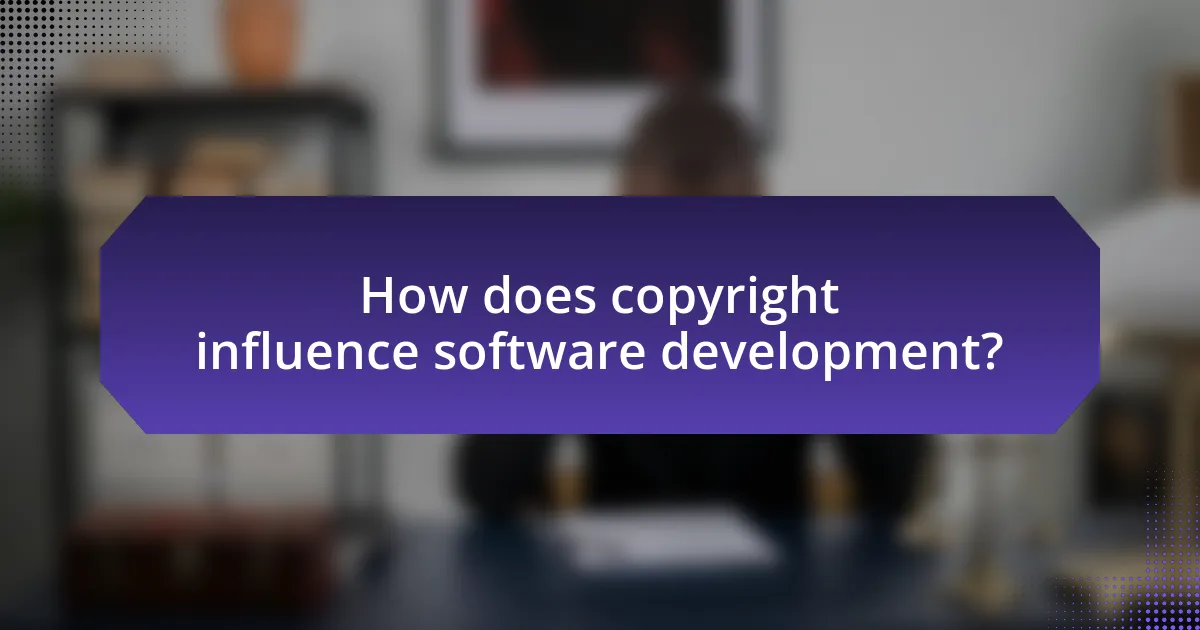
How does copyright influence software development?
Copyright significantly influences software development by providing legal protection for original code and software designs, which encourages innovation and investment. This legal framework ensures that developers can control the use and distribution of their software, preventing unauthorized copying and distribution that could undermine their financial returns. For instance, the U.S. Copyright Act of 1976 grants copyright protection to original works of authorship, including software, allowing developers to enforce their rights against infringement. This protection fosters a competitive environment where developers are incentivized to create new software solutions, knowing their intellectual property is safeguarded.
What are the fundamental principles of copyright in software?
The fundamental principles of copyright in software include the protection of original works of authorship, the exclusive rights granted to creators, and the limitation of those rights to prevent infringement. Copyright law protects the expression of ideas in software, such as source code and object code, while not protecting the underlying ideas or algorithms. This means that the creator has the exclusive right to reproduce, distribute, and modify their software, as established by the U.S. Copyright Act of 1976. Additionally, copyright does not require registration for protection, but registration provides legal advantages in enforcement. These principles ensure that software developers can control their creations and benefit from their work, fostering innovation and investment in software development.
How does copyright protect software code and documentation?
Copyright protects software code and documentation by granting exclusive rights to the creators, preventing unauthorized reproduction, distribution, and modification. This legal framework ensures that the original authors maintain control over their work, allowing them to license or sell their software while prohibiting others from using it without permission. According to the U.S. Copyright Office, software code is considered a literary work, which means it is automatically protected upon creation, provided it is fixed in a tangible medium. This protection extends to both the source code and the accompanying documentation, safeguarding the expression of ideas rather than the ideas themselves.
What are the limitations of copyright in software development?
Copyright in software development has several limitations, primarily concerning the protection scope, duration, and the nature of ideas versus expression. Copyright protects the specific expression of ideas in software code but does not extend to the underlying ideas, algorithms, or methods of operation. This means that while the code itself can be copyrighted, others can independently create similar software using the same concepts without infringing copyright. Additionally, copyright protection lasts for a limited time, typically the life of the author plus 70 years, after which the software enters the public domain. Furthermore, copyright does not protect functional aspects of software, such as user interfaces or system architecture, which can be freely replicated. These limitations highlight the balance between protecting creators’ rights and allowing innovation and competition in the software industry.
Why is copyright important for software developers?
Copyright is important for software developers because it protects their original code and intellectual property from unauthorized use and reproduction. This legal protection incentivizes innovation by ensuring that developers can control the distribution and commercialization of their software, thereby safeguarding their financial interests. According to the U.S. Copyright Office, copyright grants exclusive rights to creators, allowing them to license their work and prevent others from copying or distributing it without permission. This framework fosters a competitive environment where developers can invest time and resources into creating new software, knowing that their creations are legally protected.
How does copyright affect the ownership of software projects?
Copyright grants the creator of a software project exclusive rights to its use and distribution, thereby establishing ownership. This legal framework protects the original code, design, and documentation from unauthorized reproduction or modification, ensuring that the creator retains control over how the software is utilized. For instance, under the U.S. Copyright Act, software is classified as a literary work, which means that the author automatically holds copyright upon creation, without the need for registration. This legal protection incentivizes innovation by allowing developers to monetize their work and prevents others from claiming ownership or profiting from it without permission.
What are the implications of copyright infringement for developers?
Copyright infringement can lead to significant legal and financial consequences for developers. When developers infringe on copyright, they may face lawsuits, which can result in costly settlements or damages awarded to the copyright holder. For instance, a study by the Software Freedom Law Center indicates that developers can incur legal fees exceeding $100,000 in copyright infringement cases. Additionally, copyright infringement can damage a developer’s reputation, leading to loss of trust from clients and users, which can impact future business opportunities. Furthermore, developers may be subject to injunctions that prevent them from distributing or using their software, severely hindering their projects and financial viability.
How does copyright shape the software development lifecycle?
Copyright significantly influences the software development lifecycle by establishing legal protections for original code and software designs. This legal framework ensures that developers can secure their intellectual property, which incentivizes innovation and investment in software projects. For instance, copyright laws prevent unauthorized copying and distribution of software, compelling developers to implement robust licensing agreements and compliance measures throughout the development process. Additionally, the necessity to respect existing copyrights often leads to the adoption of open-source licenses or the creation of proprietary software, shaping decisions on technology stacks and collaboration methods. The impact of copyright is evident in the need for thorough documentation and legal reviews during the planning and deployment phases, ensuring that all components used in software development are compliant with copyright regulations.
What role does copyright play in the planning and design phases?
Copyright plays a crucial role in the planning and design phases of software development by protecting the original works created during these stages. This protection ensures that the intellectual property rights of developers and designers are upheld, preventing unauthorized use or reproduction of their ideas, designs, and code. For instance, when a software team drafts specifications or creates prototypes, copyright safeguards these materials, allowing the creators to control how their work is used and distributed. This legal framework encourages innovation by providing a secure environment for developers to invest time and resources into their projects, knowing that their contributions are legally protected from infringement.
How does copyright influence testing and deployment of software?
Copyright significantly influences the testing and deployment of software by establishing legal protections for original code and related assets. This legal framework ensures that developers must obtain permission or licenses to use copyrighted materials, which can affect the selection of libraries, frameworks, and tools during the testing phase. For instance, if a developer uses a third-party library without proper licensing, they risk legal repercussions, which can delay deployment and increase costs. Additionally, copyright laws dictate how software can be distributed, requiring compliance with licensing agreements that may impose restrictions on modifications or redistribution. This compliance is crucial for ensuring that the software can be deployed without infringing on the rights of the original creators, thereby maintaining the integrity of the development process and protecting against potential lawsuits.
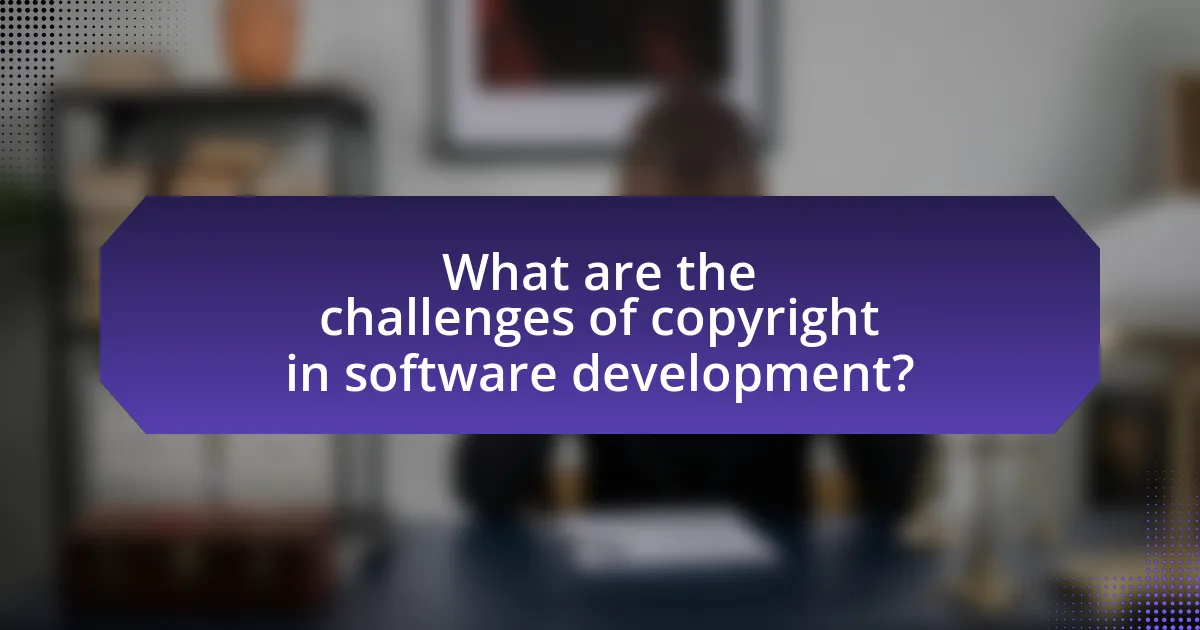
What are the challenges of copyright in software development?
The challenges of copyright in software development include ambiguity in copyrightability, difficulty in enforcing rights, and the rapid pace of technological advancement. Ambiguity arises because not all software elements, such as algorithms or user interfaces, are clearly protected under copyright law, leading to uncertainty about what can be copyrighted. Enforcement is challenging due to the global nature of software distribution, where infringing parties may operate in jurisdictions with varying copyright laws, complicating legal recourse. Additionally, the fast evolution of technology often outpaces existing copyright frameworks, making it difficult for developers to navigate compliance and protect their intellectual property effectively.
How do open-source licenses interact with copyright laws?
Open-source licenses operate within the framework of copyright laws by granting users specific rights to use, modify, and distribute software while still protecting the original creator’s copyright. These licenses, such as the GNU General Public License and the MIT License, explicitly outline the permissions and restrictions associated with the software, ensuring that the copyright holder retains ownership while allowing others to utilize the work under defined conditions. For instance, the GNU General Public License requires that any derivative work also be distributed under the same license, thereby maintaining the open-source nature of the software and reinforcing the copyright holder’s rights. This interaction ensures that open-source software can be freely shared and improved upon, while still respecting the legal rights of the original authors.
What are the key differences between permissive and copyleft licenses?
Permissive licenses allow software to be freely used, modified, and distributed with minimal restrictions, while copyleft licenses require that any derivative works also be distributed under the same license terms. The key difference lies in the conditions imposed on redistribution; permissive licenses do not impose such conditions, enabling proprietary use, whereas copyleft licenses ensure that the same freedoms are preserved in derivative works, promoting open-source principles. For example, the MIT License is a permissive license, allowing proprietary modifications, while the GNU General Public License (GPL) is a copyleft license, mandating that any modified versions remain open-source.
How can developers navigate copyright issues in open-source projects?
Developers can navigate copyright issues in open-source projects by understanding and adhering to the specific licenses governing the software. Each open-source project is typically released under a license that outlines how the software can be used, modified, and distributed. For example, licenses like the GNU General Public License (GPL) require that any derivative works also be open-sourced under the same terms, while permissive licenses like the MIT License allow for more flexibility in usage. By carefully reviewing the license terms, developers can ensure compliance and avoid potential legal disputes. Additionally, consulting legal resources or experts in intellectual property can provide further clarity on specific copyright implications related to their projects.
What are the risks of copyright violations in software development?
Copyright violations in software development can lead to significant legal and financial risks. These risks include potential lawsuits from copyright holders, which can result in costly settlements or damages, sometimes amounting to millions of dollars. Additionally, companies may face reputational damage, loss of customer trust, and disruption of business operations due to legal disputes. According to a study by the Business Software Alliance, software piracy costs the global economy over $46 billion annually, highlighting the financial implications of copyright infringement. Furthermore, developers may encounter restrictions on the use of their software, limiting innovation and collaboration opportunities.
How can developers protect themselves from copyright claims?
Developers can protect themselves from copyright claims by ensuring they use original code, obtain proper licenses for third-party libraries, and maintain thorough documentation of their work. Original code minimizes the risk of infringement, while licensed libraries provide legal protection against claims. Documentation serves as evidence of ownership and development processes, which can be crucial in disputes. Additionally, developers should consider using open-source software that complies with licensing requirements, as this can further safeguard against copyright issues.
What are the potential legal consequences of copyright infringement?
The potential legal consequences of copyright infringement include civil lawsuits, statutory damages, and criminal penalties. Civil lawsuits can result in monetary damages awarded to the copyright holder, which may range from actual damages to statutory damages of up to $150,000 per work infringed, as established by the Copyright Act of 1976. Additionally, infringers may face injunctions that prevent further use of the copyrighted material. In severe cases, criminal penalties can include fines and imprisonment, with the Copyright Act allowing for up to five years of imprisonment for willful infringement. These legal repercussions serve to protect the rights of copyright holders and deter unauthorized use of their works.
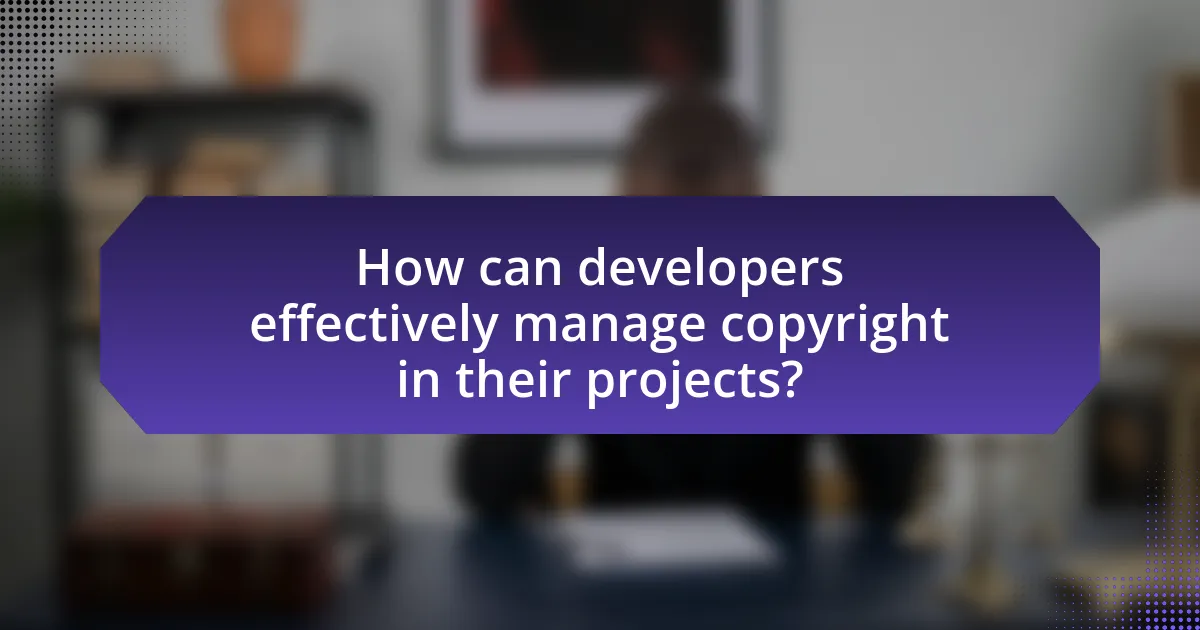
How can developers effectively manage copyright in their projects?
Developers can effectively manage copyright in their projects by implementing clear licensing agreements and maintaining thorough documentation of all code and assets used. Establishing a licensing framework, such as open-source licenses or proprietary licenses, ensures that developers understand their rights and obligations regarding the use of third-party materials. Additionally, keeping detailed records of contributions, including authorship and modification history, helps in asserting copyright claims and avoiding potential disputes. According to the U.S. Copyright Office, proper documentation can serve as evidence in legal situations, reinforcing the importance of these practices in safeguarding intellectual property.
What best practices should developers follow regarding copyright?
Developers should adhere to several best practices regarding copyright to ensure compliance and protect their work. First, they must understand and respect copyright laws, which grant exclusive rights to creators over their original works, including software code. Developers should always attribute and seek permission for any third-party code or resources they use, as unauthorized use can lead to legal repercussions. Additionally, they should maintain clear documentation of their own code to establish ownership and facilitate licensing. Regularly reviewing and updating licenses for their projects is also essential to ensure they align with current legal standards. Following these practices helps mitigate risks associated with copyright infringement and fosters a culture of respect for intellectual property in the software development community.
How can developers ensure compliance with copyright laws?
Developers can ensure compliance with copyright laws by obtaining proper licenses for any third-party software, code, or content they use. This involves researching and understanding the licensing agreements associated with the materials, which may include open-source licenses, proprietary licenses, or public domain resources. For instance, the GNU General Public License (GPL) requires that any derivative work also be open-sourced under the same license, while proprietary licenses may impose restrictions on redistribution. By adhering to these licensing terms and keeping thorough documentation of all licenses and permissions, developers can mitigate the risk of copyright infringement and legal repercussions.
What resources are available for understanding copyright in software?
Resources available for understanding copyright in software include the U.S. Copyright Office website, which provides comprehensive guidelines and legal information regarding copyright laws applicable to software. Additionally, the Electronic Frontier Foundation offers articles and resources that explain copyright issues in the context of technology and software development. The World Intellectual Property Organization also provides international perspectives on copyright laws affecting software. Furthermore, legal textbooks such as “Copyright Law in a Nutshell” by Arthur R. Miller and “Software Copyright Law” by David I. Bainbridge serve as valuable references for in-depth understanding. These resources collectively offer foundational knowledge and practical insights into copyright as it pertains to software development.
What tools can assist in managing copyright issues in software development?
Tools that can assist in managing copyright issues in software development include copyright management software, version control systems, and legal compliance tools. Copyright management software, such as Copyright Clearance Center, helps developers track and manage licenses for third-party code and content. Version control systems like Git not only facilitate collaboration but also maintain a history of code changes, which can be crucial in proving ownership and compliance. Legal compliance tools, such as Open Source Compliance Management tools, assist in ensuring that software adheres to licensing requirements, thereby mitigating copyright risks. These tools collectively enhance the ability to navigate copyright complexities in software development effectively.
How can version control systems help with copyright management?
Version control systems assist with copyright management by providing a clear record of authorship and changes made to a project. These systems track every modification, allowing developers to identify who contributed what and when, which is crucial for establishing ownership rights. For instance, Git, a widely used version control system, maintains a history of commits that includes the author’s information and timestamps, thereby creating an auditable trail of contributions. This documentation can serve as evidence in copyright disputes, reinforcing the legal standing of creators by demonstrating their involvement in the development process.
What role do copyright management tools play in software projects?
Copyright management tools play a crucial role in software projects by ensuring compliance with copyright laws and protecting intellectual property. These tools help developers track the usage of copyrighted materials, manage licenses, and facilitate the proper attribution of third-party code. For instance, tools like FOSSA and Black Duck provide automated scanning and reporting features that identify open-source components and their associated licenses, thereby reducing the risk of legal issues. By implementing these tools, organizations can maintain a clear understanding of their software’s legal obligations, which is essential for mitigating potential copyright infringement claims and fostering a culture of respect for intellectual property within the development team.
What are the future trends in copyright and software development?
Future trends in copyright and software development include increased emphasis on open-source licensing, the rise of artificial intelligence in code generation, and the adaptation of copyright laws to address digital environments. Open-source licensing is gaining traction as developers seek collaborative approaches, with over 80% of software projects incorporating open-source components, according to the 2021 Open Source Security and Risk Analysis report. The integration of AI tools, such as GitHub Copilot, is transforming how software is developed, raising questions about authorship and copyright ownership. Additionally, copyright laws are evolving to better protect software innovations in the digital age, as seen in recent legislative efforts in various countries to update intellectual property frameworks to accommodate emerging technologies.
How might changes in copyright law impact software innovation?
Changes in copyright law can significantly impact software innovation by altering the balance between protection and accessibility. Stricter copyright laws may limit the ability of developers to build upon existing software, stifling creativity and collaboration, while more lenient laws could encourage innovation by allowing easier access to source code and ideas. For instance, the introduction of open-source licenses has historically fostered rapid advancements in software development by enabling developers to share and modify code freely, demonstrating that flexible copyright frameworks can enhance innovation. Conversely, overly restrictive copyright protections can lead to a decrease in the diversity of software solutions available, as seen in industries where proprietary software dominates, limiting competition and technological progress.
What emerging technologies could influence copyright practices in software?
Emerging technologies such as blockchain, artificial intelligence, and machine learning could significantly influence copyright practices in software. Blockchain technology enables transparent and immutable tracking of ownership and usage rights, which can streamline licensing processes and reduce disputes. Artificial intelligence can create original works, raising questions about authorship and ownership, as seen in cases like the AI-generated artwork that sparked legal debates. Machine learning algorithms can analyze vast amounts of data to identify copyright infringements more efficiently, potentially leading to more proactive enforcement of rights. These technologies are reshaping the landscape of copyright by introducing new challenges and opportunities for software developers and copyright holders.
